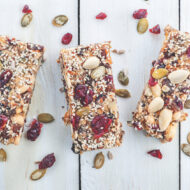
By Tapp Francke
With all the hype around gluten-free food, people often ask me, “What’s the big deal? People have been eating wheat for thousands of years.” They’re right, of course. Wheat is called the “staff of life” for a reason: it has been nourishing us since the dawn of civilization.
As far back as the ancient Egyptians, wheat has been a mainstay in the human diet. So, what happened that changed this nourishing grain into a toxin for many people?
The answer is that what we eat now is not the wheat our ancestors ate. It’s not even the wheat our grandparents ate. The wheat we grew in this country a scant 50 years ago does not even resemble the over-processed, pesticide-laden, gluten-packed stuff that is common throughout the western world. Most of the wheat in our current food supply is a dwarf variety that has been hybridized to have as much as 10 times the amount of gluten as its ancestors 100 years ago. This, plus the pesticides, fungicides and over-processing has made wheat almost unrecognizable from its original nutritious form.
In just 10 years, the numbers of reported gluten intolerances and celiac disease have seen a meteoric rise. One report found that while only 1 in 2500 people reported a gluten intolerance in 1990, the number is 1 in 133 today.
What is gluten? Gluten is a protein found in wheat and other grains like spelt, rye, barley and kamut. It’s the “glue” holding together most baked goods, as well as some candies. It is used as a thickening agent for soups, glazes, marinades and sauces. Gluten can also be found in processed deli meats, textured vegetable protein, lipstick and Play-Doh, among other unlikely places.
The problem is that gluten is difficult for some people to digest. Gluten intolerance occurs when the body reacts to gluten as it would to a virus or bacteria. It sees the protein as a foreign invader and attacks. This is called an immune response. This response creates inflammation, and inflammation can contribute to everything from joint pain to headaches, eczema, an inability to concentrate and fatigue, as well as the more common stomach pain and indigestion.
A common misconception is that gluten intolerance and celiac disease are interchangeable terms. They’re caused by a common culprit, and both conditions create an immune response in the body. The difference is that celiac disease also creates an auto-immune response, which means that the body not only attacks the foreign invader, but it also attacks itself. This results in the villi in the small intestine being damaged by the body’s immune system. The villi absorb the nutrients from the food we eat, so most people with untreated celiac disease will also show signs of malnourishment.
Both gluten intolerance and celiac disease create major disruptions in the way your body digests food. Doctors and scientists are discovering many ways that gluten can impact your health. A newly recognized form of celiac is called behavioral celiac. This condition occurs when the symptoms tend more towards disruptive behavior and an inability to concentrate than the more common signs of celiac, and is often misdiagnosed as ADHD.
If you are intolerant, you can be having a chronic low level inflammatory response and not even know it. Maybe you are tired in the afternoon or tend to get headaches or feel bloated. Maybe you think that this is not a big deal. The fact is that this low-level inflammation is the root cause of many diseases, and should be taken seriously.
Unlike celiac, there is no reliable test for gluten intolerance. The best way to find out if you are gluten intolerant is to remove it from your diet for a minimum of 28 days. Keep in mind that gluten is everywhere. You need to be vigilant about keeping it out of your diet for that time period. The Standard American Diet is packed with gluten. It is in nearly all processed and fast foods because it is inexpensive and versatile.
After 28 days, add it back in and see how you react. To test your reaction, you’ll want to eat a lot of it, and consume it in the morning. The best choice would be a bagel, which is like a brick of gluten.
Everybody’s body is different and you may be one of the many people who discovers it improves their health, mood and overall wellness.
I should note that gluten-free food does not equal health food. Many gluten-free substitutes are made from GMO corn flour and processed white rice flour; eating them is, in terms of health, akin to switching seats on the Titanic. I recommend choosing your gluten-free foods wisely. The better ones are made with quinoa, chickpea, almond, sorghum, amaranth, cassava, teff, buckwheat (yes, it is gluten-free) and coconut flour.
Five gluten-free brands I love:
- Jennifer’s Way Bakery has awesome bagel chips. http://livingfreejennifer.com
- I love Canyon Bakehouse’s hamburger buns and whole-grain bread. http://canyonglutenfree.com
- Know Better Bread makes energy bars, mini muffins and donuts that are low sugar, high protein and delicious, http://knowfoods.com
- Namaste has an excellent pancake mix. http://namastefoods.com
- Coconut Secret offers a teriyaki sauce and a soy-sauce replacement called Coconut Aminos. http://coconutsecret.com








